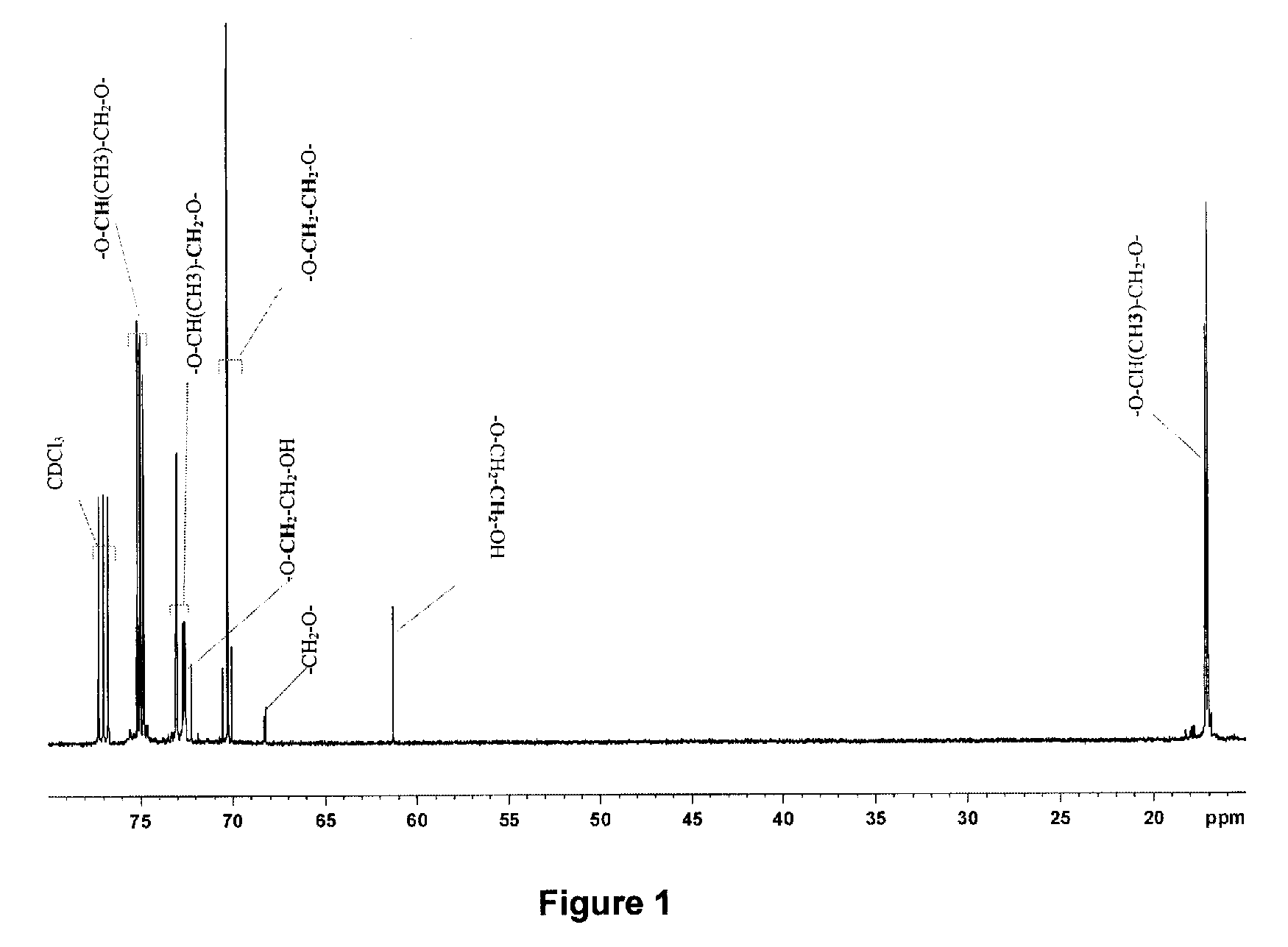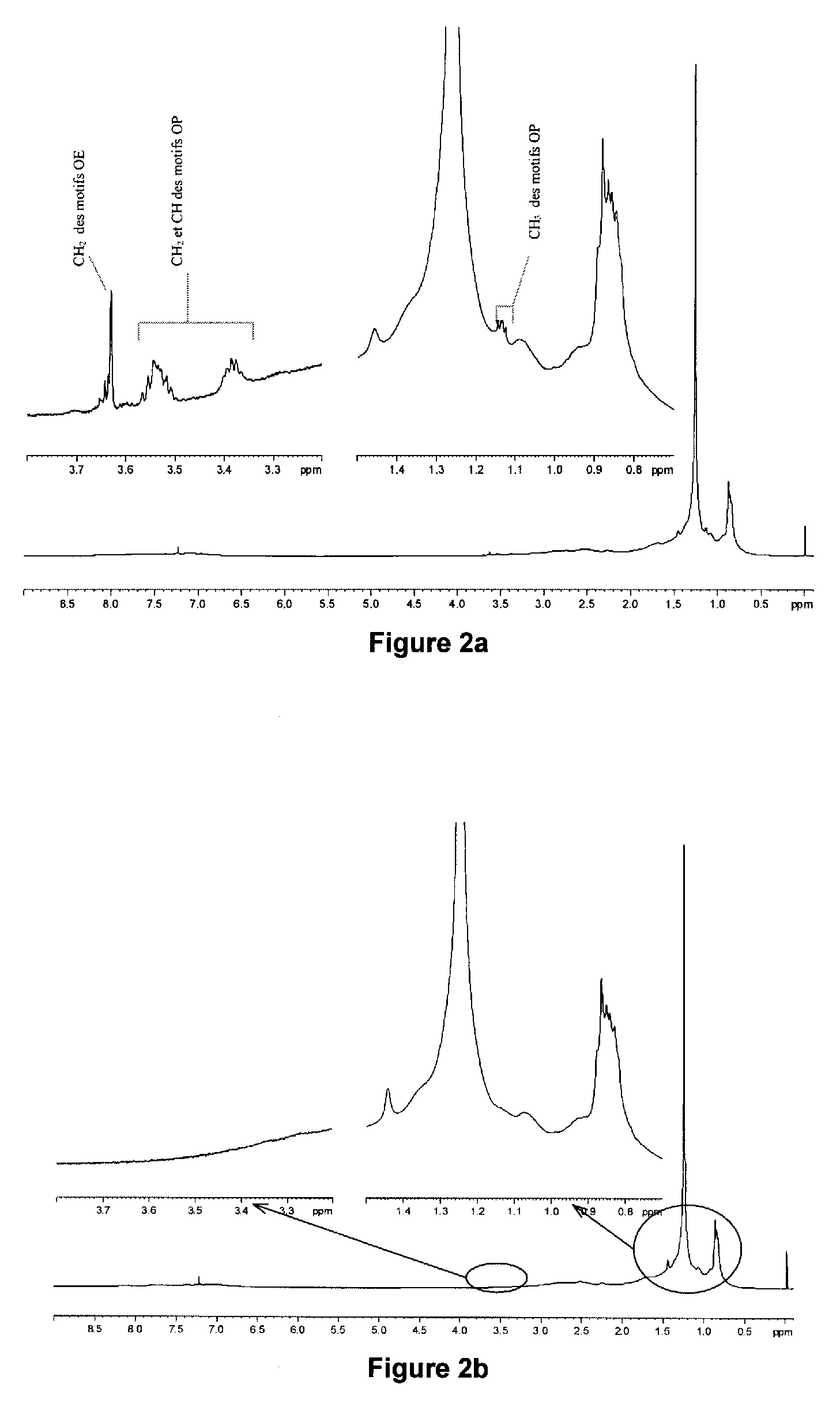Bituminous products and aqueous emulsions based on bituminous products and uses thereof
a technology which is applied in the field of bitumen products and aqueous emulsions based on bitumen products, can solve the problems of increasing the brittleness the risk of degrading the behavior of the bitumen mix, and the standard paraffin wax content of bitumen being exceeded
- Summary
- Abstract
- Description
- Claims
- Application Information
AI Technical Summary
Benefits of technology
Problems solved by technology
Method used
Image
Examples
example 1
[0082]The following additives were added to a 35 / 50 penetration index bitumen known as TOTAL Azalt, originating from the Feyzin refinery:[0083]Additive 1 (type A): polymer from the class of ethylene oxide / propylene oxide block copolymers, with a molecular weight Mw of around 4500 g / mol and a weight ratio of ethylene oxide to (ethylene oxide+propylene oxide) of around 40%, sold under the name Pluronic P94;[0084]Additive 2 (type B): the blend, in 70 / 30 weight proportions, of the polymer from the class of ethylene oxide / propylene oxide block copolymers, with a molecular weight Mw of around 3400 g / mol and a weight ratio of ethylene oxide to (ethylene oxide+propylene oxide) of around 20%, sold under the name Pluronic L92 and the product A1 of chemical formula (R—O—(CH2CH—(CH3)O)a—(CH2CH2O)b)cP(═O)—OHd where P is a phosphorus atom, c is between 1 and 2, c+d is equal to 3, a is equal to 0, b is equal to 4 and R represents a hydrocarbon-based chain having between 12 and 14 carbon atoms, the...
example 2
[0089]The following additives were added to a TOTAL Aqualt 70 / 100 penetration index bitumen, originating from the Donges refinery:[0090]Additive 5 (type A): the polymer from the class of ethylene oxide / propylene oxide block copolymers, with a molecular weight Mw of around 3400 g / mol and a weight ratio of ethylene oxide to (ethylene oxide+propylene oxide) of around 20%, sold under the name Pluronic L92;[0091]Additive 6 (type D1): the blend, in 80 / 20 weight proportions, of the polymer from the class of ethylene oxide / propylene oxide block copolymers, with a molecular weight Mw of around 3400 g / mol and a weight ratio of ethylene oxide to (ethylene oxide+propylene oxide) of around 20%, sold under the name Pluronic L92, and the result of the condensation of aminoethyl-piperazine and a vegetable oil having fatty chains that contain from 14 to 18 carbon atoms, having an iodine value above 90, obtained by pouring the vegetable oil over aminoethylpiperazine at 150° C. for 2 h, then by heatin...
example 3
[0095]In a fixed plant possessing a drier / mixer drum, a 0 / 10 BBSG (a semi-coarse bituminous concrete) of Class 3 was manufactured in four different grades, all four having the following granular formula:
[0096]
calcareous fillerlimestone 5%0 / 2 sandrhyolite34%2 / 6 aggregatesrhyolite12%6 / 10 aggregatesrhyolite 49%.
[0097]The bitumen used was a 35 / 50 Azalt from TOTAL with the following characteristics: penetration index at 25° C. equal to 40; 1.032 density; 51° C. ring-and-ball softening point. The content of bituminous product was 6.1 g per 100 g of aggregates. For the first two grades, the bitumen was used pure. For the third grade, the following additive was added to the bitumen, with a dose of 5 kg per metric ton of bitumen:[0098]Additive 8 (type B): the blend, in 70 / 20 / 10 weight proportions respectively, of the polymer from the class of ethylene oxide / propylene oxide block copolymers, with a molecular weight Mw of around 3400 g / mol and a weight ratio of ethylene oxide to (ethylene oxid...
PUM
| Property | Measurement | Unit |
|---|---|---|
| temperature | aaaaa | aaaaa |
| temperature | aaaaa | aaaaa |
| temperature | aaaaa | aaaaa |
Abstract
Description
Claims
Application Information
 Login to View More
Login to View More - R&D
- Intellectual Property
- Life Sciences
- Materials
- Tech Scout
- Unparalleled Data Quality
- Higher Quality Content
- 60% Fewer Hallucinations
Browse by: Latest US Patents, China's latest patents, Technical Efficacy Thesaurus, Application Domain, Technology Topic, Popular Technical Reports.
© 2025 PatSnap. All rights reserved.Legal|Privacy policy|Modern Slavery Act Transparency Statement|Sitemap|About US| Contact US: help@patsnap.com


